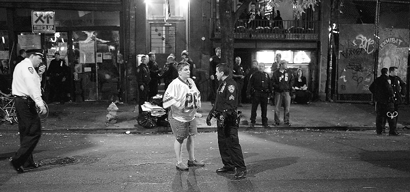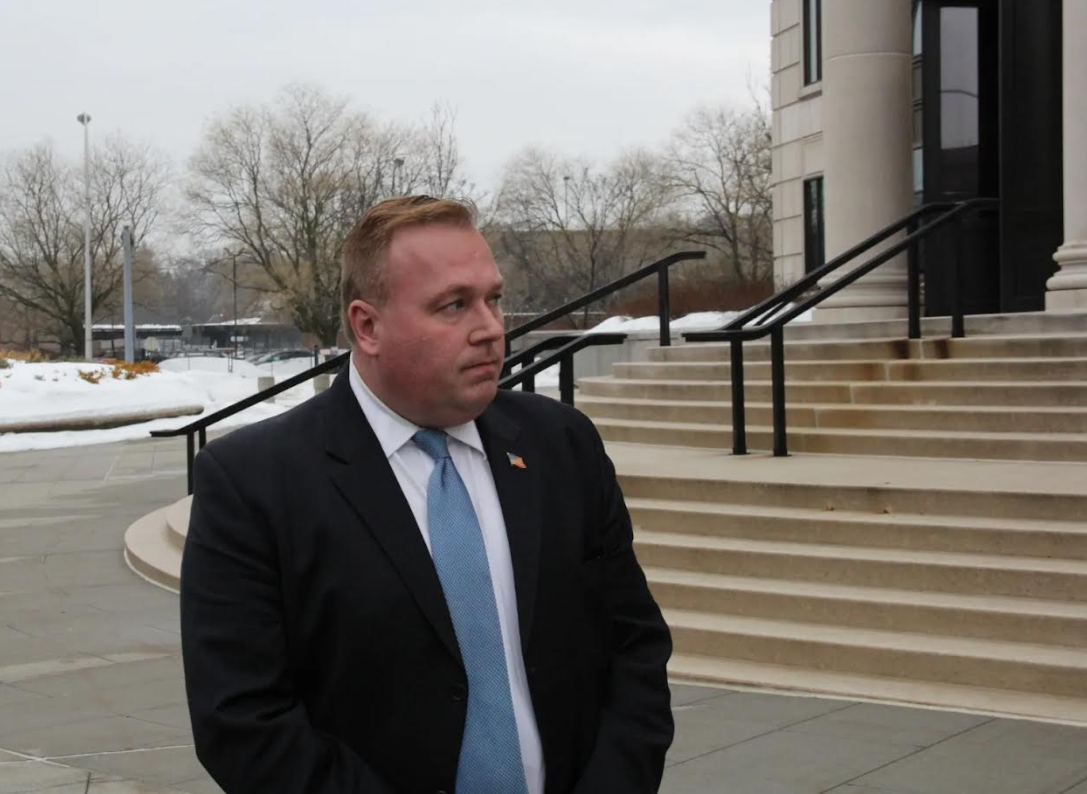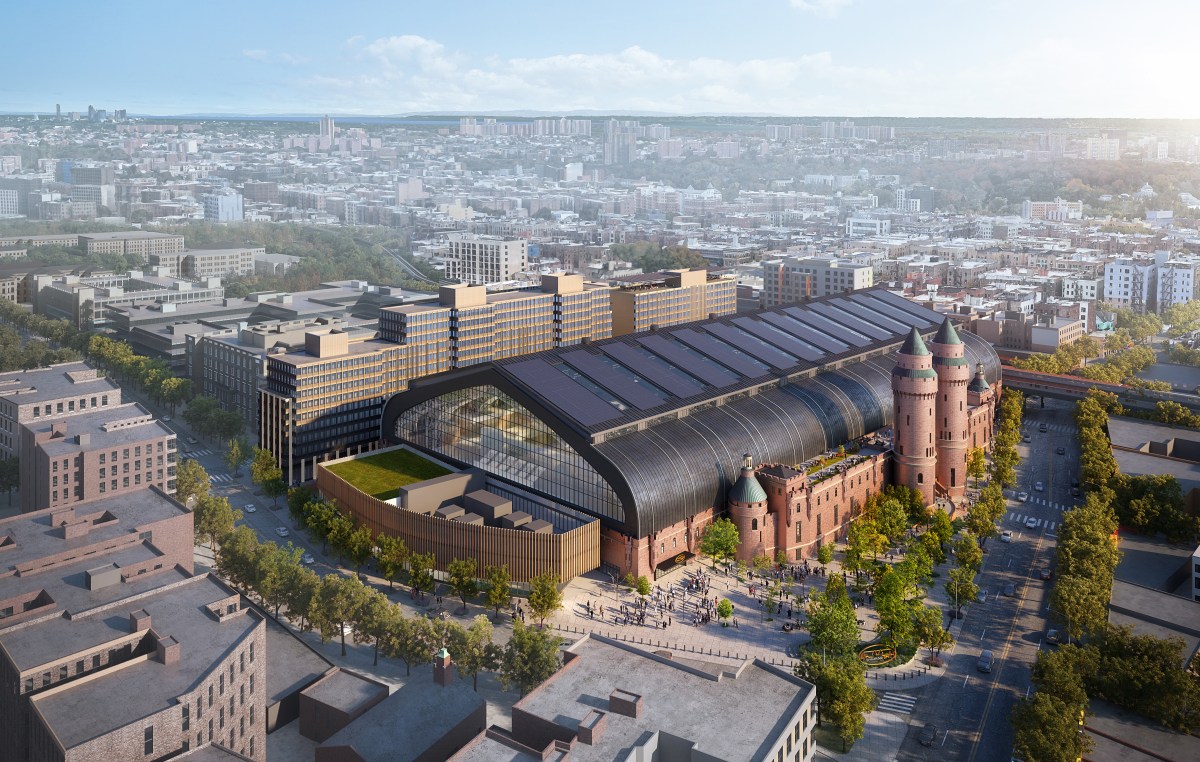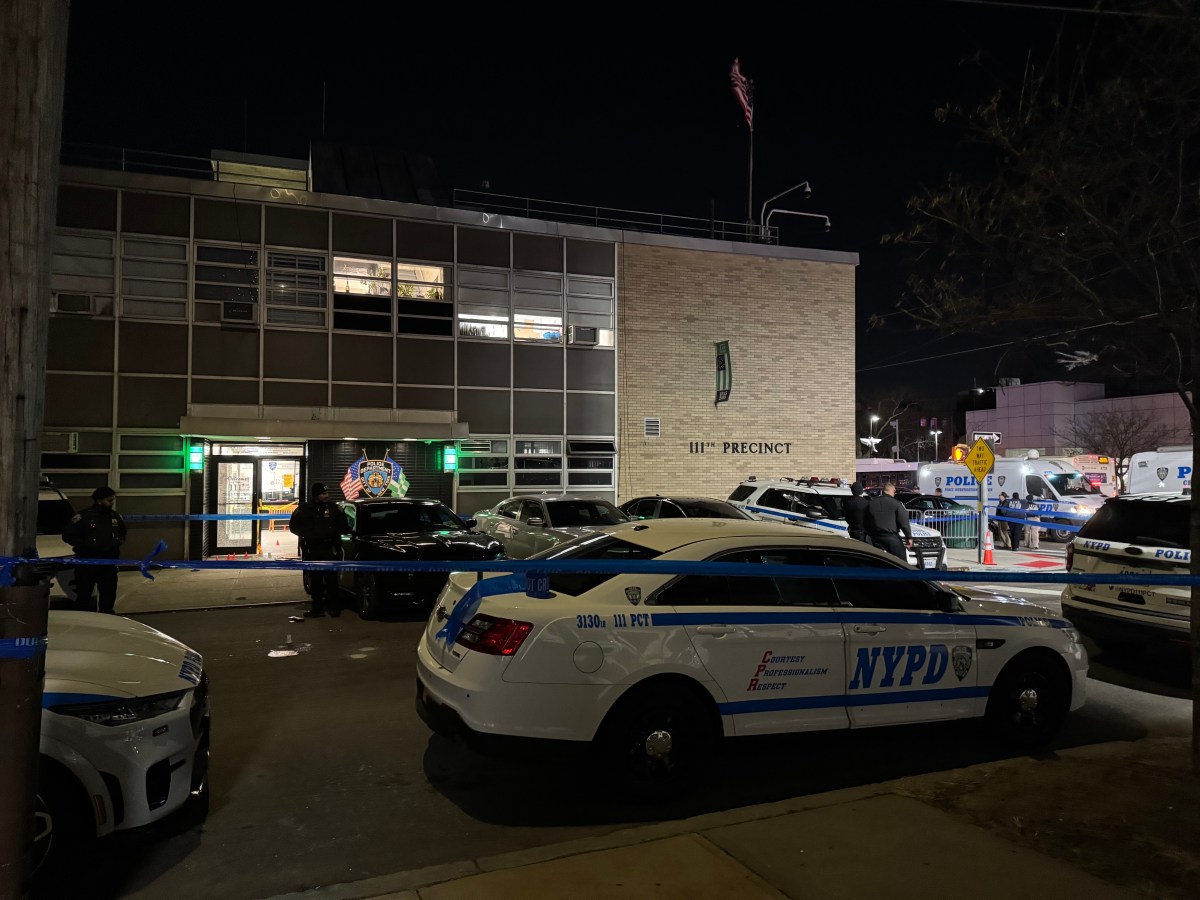By Lincoln Anderson
If the Critical Mass bicyclists thought they had won some protection with a federal judge’s rulings in their dueling lawsuits with the city last week, Friday night’s events proved that assumption wrong — and left the bikers charging that the city is continuing to target them.
Last Thursday, saying the city had waited until too close to the date of the event, Judge William Pauley III denied the city’s request for an injunction blocking the monthly ride from occurring unless it received a permit. But Pauley did grant a partial injunction on a lawsuit filed by two civil rights attorneys, Norman Siegel and Steven J. Hyman, on behalf of five Critical Mass cyclists, to prevent police from cutting locks and confiscating unattended bicycles during the ride.
By the end of last Friday night, however, police had arrested 33 bikers during the Critical Mass ride and, with an extremely heavy show of force, shut down the group’s after-party on E. Houston St., arresting seven more persons for disorderly conduct in the process. In addition, police cut the locks on and seized at least three bicycles near the after-party.
The night had started with about 1,000 bikers, many in festive Halloween costumes, assembling as usual on the last Friday of the month at dusk at Union Sq. N. Police distributed fliers informing them to follow a route up Park Ave., across 55th St. and back down Fifth Ave. and Broadway to Union Sq. Police on scooters helpingly blocked cross-town traffic at all intersections along the way. However, as the riders headed back Downtown they split into four groups, some heading across 42nd St. and zigzagging down the West Side, playing cat and mouse with the police.
Police were prepared for mass arrests. No less than seven of the large orange nets used to capture bikers and protesters during the Republican National Convention were spotted in Union Sq. and two were unrolled on the street at one point. There was also a big, flatbed truck, like the ones used to cart off bikes confiscated from the more than 250 riders arrested during the August Critical Mass before the R.N.C.
After last Friday’s ride, some of the bikers celebrated at an after-party at the 49 E. Houston St. storefront space of Time’s Up!, a pro-bicycling, nonprofit environmental group that publicizes Critical Mass. It was described as a private affair, with donations for entry and drinks on a sliding scale. The crowd spilled out onto the sidewalk in front and the party was also occurring in an open, outdoor space two doors to the west.
Around midnight, a group in the basement — where bicycle wheels hung from the ceiling like mobiles — were singing “Will the real Dick Cheney please stand up?” to the tune of Eminem’s “Slim Shady,” while upstairs dancers grooved to house music.
Outside, bikes of all kinds — customized high-rise ones and choppers worthy of “The Road Warrior” — were piled in mounds around tree pits. A lane of traffic in the street had been blocked off with barriers.
Wearing a white wig and disco costume and boogying in the street by the curb, Bill Di Paolo, founder and executive director of Time’s Up!, said the ride had been a success, despite the arrests.
“Victory! Victory all around!” he said, twirling a woman by the arm.
However, just minutes later, several police cars and an unmarked blue van pulled up. According to Matthew Roth, a Time’s Up! spokesperson, there were about 80 to 100 people inside the space and about 50 to 60 on the sidewalk outside, at the time.
Special Operations Lieutenant Carolyn Fanale of the Fifth Police Precinct went to work. A powerfully built woman with close-cropped brown hair, she was dressed for action in plain clothes, a Redskins Cliff Portis # 26 football jersey and jean shorts, a cigar clenched in her teeth. According to Atom, a man who had been watching the outdoor space, Fanale — her badge at her neck — first looked around there. She then gave a summons to a man with dreadlocks for having an open beer on the sidewalk.
Suddenly, in a flurry of activity, Fanale next came shooting away from the Time’s Up! storefront, a man in a red T-shirt in tow, and threw him onto the trunk of a police car. She then made to bolt back inside the building — but the bikers blocked her at the door.
“Show us a warrant!” they chanted. National Lawyers Guild observers still on the scene after monitoring the ride, advised the group to also chant, “We do not consent to this search!”
The bikers claimed Fanale had been inside the storefront space, knocking people’s beers, trying to instigate something. A black, dreadlocked undercover officer had also pushed his way in, but retreated, they said.
More police arrived and formed a cordon in front of the space. An announcement was made to disperse or face arrest. By slowly walking at the crowd on either side, the police moved them toward Mott and Mulberry Sts., clearing the block. Some inside the Time’s Up! space escaped through a back entrance, though others waited for attorney Siegel to show up and help get them out.
During the standoff one officer was observed taking something out of his pocket and shaking it.
“Watch it with the Mace,” warned one of the bicyclists.
A bit later, an officer with what appeared to be a shotgun was seen walking on the north side of the Houston St. median. Some thought it was a pepper-spray or teargas gun. Others were sure it was a shotgun.
The block of Houston St. was closed down by police except for a lane of traffic on the north side. Lingering on the perimeter after being moved off, some bikers accused the police of having a vendetta against Critical Mass.
“Because they’re embarrassed they lost in court, they came here to provoke an incident,” accused Jacques Aboaf, 24, an N.Y.U. anthropology student.
“I feel like I’m about to cry,” said Sam Wilson, 25, wearing a long paper clown nose. “I don’t know how humans could act like that to other humans — it’s painful to see.”
“These aren’t N.Y.U. frat boys — these are peaceful hippies,” said Andrew Kennis, 28, marveling at the forceful police response to the party.
According to Time’s Up!’s Roth, one woman who had been filming the police action had her hand injured after police grabbed her and she refused to drop the camera.
Not long after, the loud sound of a power saw could be heard. A day after Judge Pauley’s injunction against police cutting bike locks, Lieutenant Fanale was overseeing the sawing of locks of bikes on the Puck Building’s fence on Mulberry St., from which police reportedly confiscated three bikes; a Villager reporter arrived in time to see Fanale wheeling away the last of them. Time’s Up!’s Di Paolo said some bikes locked on the Houston St. median were also taken.
According to the injunction granted by Judge Pauley, police cannot seize locked bikes unless the owners are notified why or are arrested or the bikes are obstructing pedestrian or vehicular traffic.
One of the confiscated bikes, a Trek 1100, belongs to a man who goes by Tomas, a 63-year-old photographer and former East Village squatter.
“I wasn’t aware they were sawing the bikes. Terrible — I really rely on my bike,” he said shortly afterward, sounding at a loss. He recovered the bike at the Fifth Precinct four days later.
A man with an Eastern European accent answering the door at the Puck Building early Saturday morning nervously said that, no, he had not called police about the bikes on the building’s fence, though police had come to talk to him about it.
On Monday, Larry Schwartz, the Puck Building’s catering manager, who wasn’t at the building that night, said he didn’t ask police to cut the bike locks and would know if someone else had.
“I had nothing to do with that — and I don’t think anybody knew anything about it,” Schwartz said. “We had no parties that night, so why would I tell police to do that? The bicycles are always on the fence, messengers…. That’s penny-ante [stuff]. I wouldn’t do that.”
However, Deputy Commissioner Paul Browne, the Police Department’s top spokesperson, said they had received a complaint at 1:05 a.m. Saturday morning stating that Lukasz Kolodziejczyk, “the manager of the Puck Building, requested that bicycles chained to his property be removed.”
As for why police responded to the Time’s Up! party, Browne said, there was a report of 200 or more people at and in front of the location.
“The responding officers saw that the crowd, including people drinking from open containers, had spilled onto E. Houston St.,” Browne said. “They had taken some construction barriers from a nearby site to block a lane of traffic going eastbound.”
Browne said “the supervisor,” Lieutenant Fanale, arrived and instructed other officers to give out summonses for drinking outside. However, he said, “The supervisor was assaulted. They surrounded her. She was hit.” A 10-85 call was put out for additional officers. Browne said his understanding was the police used “great restraint.”
As to the bikers’ claims that Fanale instigated the incident, Browne said, “My experience with this group is when they break the law, they find a way to blame the police for misconduct. We went out of our way to try to accommodate the ride that night. They blocked traffic, ran red lights and otherwise engaged in dangerous activity.”
Asked why Fanale went inside the building, when the problems were outside, Browne said, “We have every right to take police action in a situation like this. There are people who decided to take over part of a major thoroughfare in Manhattan…. This was a large, disruptive and illegal activity.”
Asked if the response — including an apparently shotgun-toting officer — wasn’t overkill, Browne said, “What happens when a crowd resists arrest and an officer is assaulted, you’re going to get a large response.” He said a shotgun would only be carried by a Highway officer on patrol by himself, but he doubted a Highway officer would have responded.
The deputy commissioner said Critical Mass rides have gotten out of control.
“There was a time when the participants in these rides stopped for traffic lights,” he said, adding, “It’s only a matter of time, if their conduct isn’t restrained, that somebody is terribly injured. We’ve tried to work with them, but there’s this anarchist bent that says, ‘We don’t want to work with you, we don’t want to respect the law,’ that makes it hard to work with them.”
After last Friday’s ride, one participant, Molly Monosky, 26, from Chinatown listed “resisting authority” and “stopping traffic” as two reasons why she likes Critical Mass.
“We’ve had [Critical Mass] in New York for years without a problem,” Browne said. “It’s only in the months leading up to the Republican National Convention that it’s become dangerous.”
Browne said the Critical Mass rides have recently been “hijacked by people with a different agenda.” He gave as an example of a dangerous instance the July Critical Mass ride when bikers entered the F.D.R. Drive from the Battery Park underpass.
However, Time’s Up!’s Di Paolo said police created more of a confrontation on E. Houston St. last Friday night than was needed — and that it was the lieutenant, not the bikers, who was doing the hitting; that the bikers were just trying to push the police out.
“They went in the space without a warrant,” he said. “Their badges were not out. They were not dressed in police uniforms. It seemed when they went in, they went in so violently. Why not send in someone in uniform or [a supervising officer] in a white shirt? Why send in someone like that unless you’re instigating something? She hit at least 15 people. We were pushing. They were hitting. They didn’t ID themselves. They said nothing. They were just cursing.”
Di Paolo — who had been dancing in the blocked-off lane of the street when police arrived — admitted, “I guess I was a little cocky because of the injunction.”
Yet, from the sound of it, Critical Mass may be willing to make one concession — to stop running red lights.
“According to the judge, the only thing we’re doing wrong is going through red lights,” Di Paolo said. “So we don’t even have to do that.”
Based on a regulation discovered during the court proceedings, Critical Mass believes the bikers can, in fact, take up the whole street, and should not be held to the state vehicle and traffic law regulation saying bikers must ride two abreast when in the middle of the street, he said.
Although police gave a route to last Friday’s riders, because the judge denied the city’s request for an injunction without a permit for the October ride, Di Paolo said they don’t feel they need to follow a route.
“Once the ride gets going, the group goes in different directions. I don’t think it was malicious,” he said of last week’s Critical Mass. “People were just riding their bikes.
“We just want the city to tell us what we have to do,” Di Paolo said. “Stopping at red lights, that’s all we feel that [the city] has proved in court that we have to do.”
However, in his ruling — although he denied the city’s request for an injunction stopping last Friday’s ride — Judge Pauley did suggest that, for safety, Critical Mass and the city should agree on a route for the ride each month. The bikers, Pauley said, cannot simply go “ ‘wherever their wheels take them’ month after month without someone getting hurt. Bike rides of this size require coordination with the police for everyone’s safety.”
Pauley has also said that the permit case belongs in state, not federal, court, as it concerns the state’s traffic laws.




































